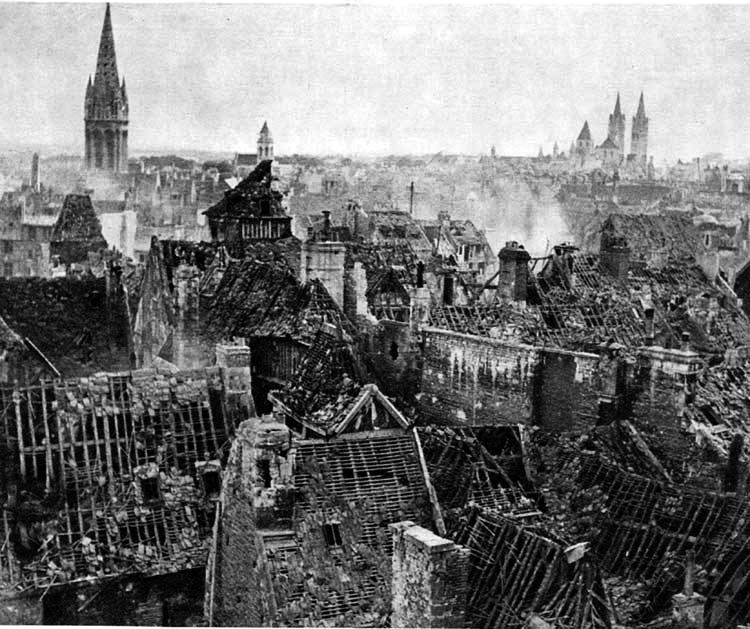 | ||
The Bombing of Normandy during the Normandy invasion was meant to destroy the German communication lines in the Norman cities and towns. However, very few Germans occupied these municipalities. German troops were mostly located outside these areas. On 9 July 1944, Field Marshal Bernard Montgomery demanded a massive air assault against Caen in hopes of clearing the way for an attack the following morning. Four hundred and fifty heavy aircraft participated, dropping 2,500 tons of bombs. The pilots however negated most of the effect by releasing their loads well back from the forward line to avoid hitting their own troops. As a result, the city incurred heavy damage but German defenses went largely unscathed.
The heavy bomber missions caused serious problems in the beginning of the operations in Normandy. The first two strikes on Caen resulted in numerous casualties to French civilians. Sometimes friendly troops were victims of misplaced bomb strikes. In the Normandy campaign, as in other campaigns, air and land forces had to get used to working together. U.S. General Omar Bradley remarked after the war that We went into France almost totally untrained in air-ground cooperation. In the early stages of the Battle of Normandy some "disconnects" did occur between the air and land communities.
According to Antony Beevor in his book D-Day, "The British bombing of Caen beginning on D-Day in particular was stupid, counter-productive and above all very close to a war crime. There was an assumption, I think, that Caen must have been evacuated beforehand. That was wishful thinking on the part of the British. There were more than 2,000 casualties there on the first two days and in a way it was miraculous that more people weren't killed when you think of the bombing and the shelling which carried on for days afterwards. French civilians, caught in the middle of these battlefields or under Allied bombing, endured terrible suffering. Even the joys of liberation had their darker side. The war in northern France marked not just a generation, but the whole of the postwar world, profoundly influencing relations between America and Europe."
The bombings also destroyed 96% of Tilly-la-Campagne (Calvados), 95% of Vire (Calvados), 88% of Villers-Bocage (Calvados), 82% of Le Havre (Seine-Maritime), 77% of Saint-Lô (Manche), 76% of Falaise (Calvados), 75% of Lisieux (Calvados), 75% of Caen (Calvados).
It is estimated that the bombings in Normandy before and after D-Day caused over 50,000 civilian deaths. The French historian Henri Amouroux in La Grande histoire des Français sous l’Occupation, says that 20,000 civilians were killed in Calvados department, 10,000 in Seine-Maritime, 14,800 in the Manche, 4,200 in the Orne, around 3,000 in the Eure. The most deadly allied bombings under the German occupation were these: Lisieux (6–7 June 1944, 700 dead), Vire (6–7 June 1944, 400 dead), Caen (6 June-19 July 1944, about 3,000 dead), Le Havre (5–11 September 1944, more than 5,000 dead)
For many families who lived through the war, it was the arrival and passage of British and American forces that was by far the most tormenting experience. According to Christophe Prime, "It was profoundly traumatic for the people of Normandy. Think of the hundreds of tons of bombs destroying entire cities and wiping out families. But the suffering of civilians was for many years masked by the over-riding image, that of the French welcoming the liberators with open arms."
